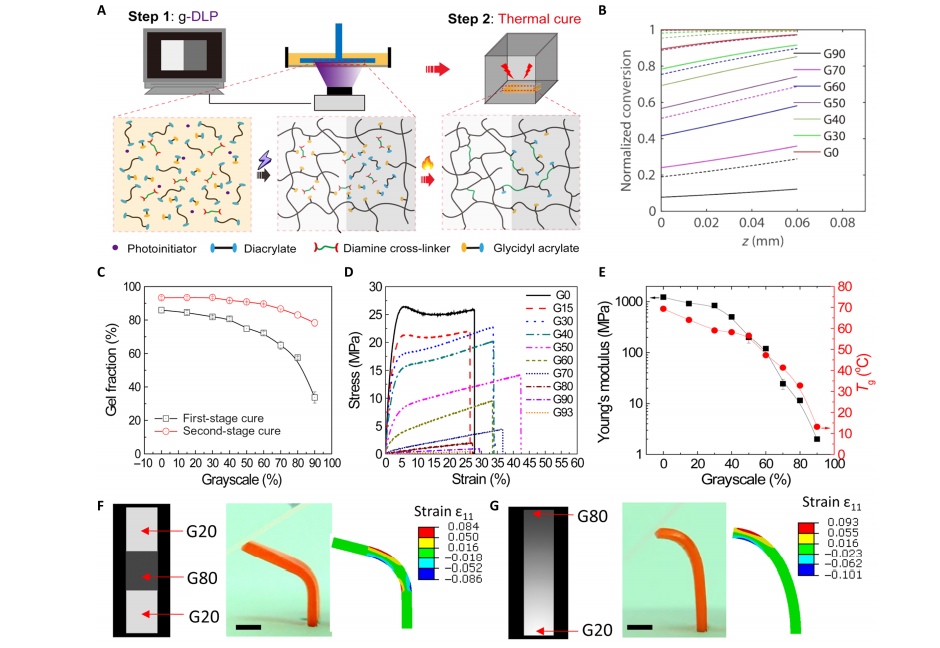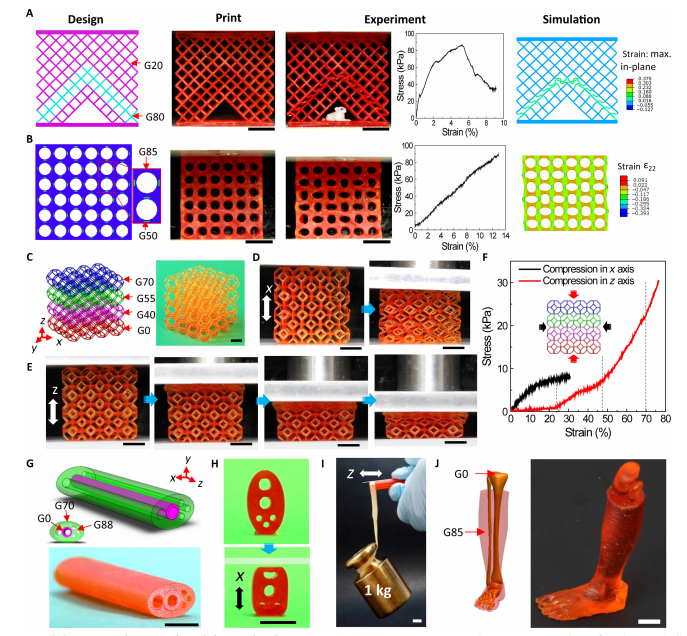In ‘Grayscale digital light processing 3D printing for highly functionally graded materials,’ Chinese researchers make it clear that 3D printing has a long way to go for producing excellence in parts without significant investment and engineering. In looking toward biological structures, the authors suggest that functionally graded materials (FGMs) can improve mechanical properties of 3D printed objects. In assessing previous studies, they also settled on DLP 3D printing as the most promising method—especially for creating multi-material parts.
In this study, the researchers explain how they created a new 3D printing ink, used in grayscale printing with the single-vat grayscale DLP (g-DLP). The ink is meant to serve as the material for fabrication of highly tunable property gradients. Cured with grayscale light patterns that form the 3D printed structure, the object is cured a second time to ‘eliminate most of the residual monomers’ and improve mechanical properties. Ultimately, the researchers discovered that ‘broadly tailored functional gradients’ could be made, as they created lattice structures and different metamaterials.

g-DLP 3D printing of FGM via two-stage curing. (A) Schematics showing the g-DLP printing of graded material via a two-stage curing process. A hybrid ink was used for
DLP 3D printing first followed by thermal curing the printed part in a heating oven. (B) Predicted normalized conversion of cured material under different grayscale light with only
one exposure (solid lines) and multiexposure (dashed lines) by the model using the exposure time of 20 s and curing thickness of 60 mm per layer. (C) Gel fraction of hybrid ink after
the first- and second-stage curing. (D) Tensile stress-strain curves of printed materials using different grayscale during printing (sample size, >3). (E) Young’s modulus and glass
transition temperature of printed materials as functions of grayscale. (F and G) Design, print part under bending, and corresponding FEM simulation of graded materials enabled
by g-DLP using a discrete gradient (F) and a continuous gradient (G) grayscale pattern. Scale bars, 5 mm.
A hybrid ink was created, and the researchers used a two-stage curing mechanism to refine the parts, with GMA monomers and diamine cross-linkers responsible for the thermal curing process. They examined the impact of grayscale on photopolymerization of the ink. Looking back at previous processes, the research team realized that two-stage curing systems usually produced uniform polymer networks or phase-separation structures. With their new method, the network was creating with both tunable density and chain architecture—without toxins, meaning that it is safe for many different applications.
“The differences in the network architecture and cross-linking density of the materials lead to widely tunable mechanical and thermomechanical properties. We first evaluated the mechanical properties of the printed materials,” stated the researchers. “The samples were printed using a single grayscale light for the first-stage curing. With only the first stage photocuring, the Young’s modulus spans only a few times from 1.5 to 8.1 MPa when the grayscale varies from G80 to G0, which is not enough for broader applications.
Continuing to show the potential of g-DLP printing, the researchers also printed simple geometrical shapes with gradients, along with further exploring 3D printing lattices and bioprinted structures which displayed high resolution and ‘clean appearance.’ They also found that these printed structures deformed suitably for applications like energy absorption, bordering on the 4D realm as shape memory polymers, envisioning use in future applications like:
- Voxel printing
- 4D printing for metamaterials
- Presurgical model planning
- Soft robotics
- Additive manufacturing with cyber security
“Although our approach enables significant advantages, there are still several issues that need to be addressed for its wide applications. First, the actual resolution of properties for the g-DLP should be determined. Besides the printer device itself, the voxel resolution for g-DLP in the x-y plane and z axis can be affected by both the resin and the printing parameters. Moreover, the grayscale value of the pixel would also have an influence on the voxel resolution. Second, the relationship between the curing condition, molecular structures, and mechanical properties of the grayscale cured samples needs to be further understood,” concluded the authors. “The nanoscale mechanical test and modeling approaches would provide an attractive pathway to this end, which is part of the ongoing work.”
“Last, when grayscale is used, polymers are cured to different degrees, which results in a slight difference in printed size. However, this can be fixed by software. For example, the projecting area with larger grayscale can be adjusted larger to compensate for the difference.”

Applications of g-DLP–printed composites for sequential SMP components and 4D printing. (A) Design and print part of a helical SMP component with increasing
grayscale level on the hinge from G20 to G80. (B) Snapshot showing the sequential shape recovery process of the helical SMP component with graded hinge materials in hot water
(~60°C). (C) Design and print part of a sequential SMP as an artificial arm. (D and E) Snapshot showing sequential shape recovery of a single artificial arm (D) and artificial arms for
soft robotics to lift a stick (E) by a heat gun. (F) Schematic of a shape-shifting film by cold drawing of printed lamina fiber-reinforced composites with asymmetric fiber distribution
and recovery process. (G) Pictures of the printed strip with 0° of fiber orientation: original shape and bending shapes by applied stretching strain at room temperature. Scale bars,
1 cm. Photo credit: Xiao Kuang, Georgia Tech
Improving mechanical properties in 3D printing is a challenge that many users have taken on lately as they hope to make stronger, more functional parts whether in scaling up nanotechnology, formulating inks and resins, or studying how other factors affect strength and durability. Find out more about how mechanical properties affect 3D printed parts and how they can be improved here. What do you think of this news? Let us know your thoughts! Join the discussion of this and other 3D printing topics at 3DPrintBoard.com.

Graded metamaterial via g-DLP for multifunctional applications. (A and B) Design, print part, experimental compression test, and FEM of a 2D lattice and cellular
metamaterial for controlled buckling (A) and pattern transformation (B), respectively. (C) Design and print part of a 3D lattice metamaterial. (Dand E) Synchronous deformation (D)
and sequential deformation (E) of the 3D lattice in the x and z axes, respectively. (F) Compression stress-strain curves of the anisotropic 3D lattice in the x and z axes. (G) Design and
print part of a limb-mimic structure with soft muscle (G88), moderate skin (G70), and stiff bone (G0) as well as hollow channels. (H) The limb-mimic structure was easily compressed
in the thickness direction. (I) The limb-mimic structure was loaded heavyweight (1 kg) without obvious bending across the length direction (z axis). (J) Design and print part of a
small-scale artificial limb structure with soft muscle (G85) and stiff bone (G0). Scale bars, 1 cm. Photo credit: Xiao Kuang, Georgia Tech.
[Source / Images: ‘Grayscale digital light processing 3D printing for highly functionally graded materials’]
